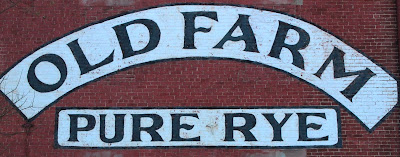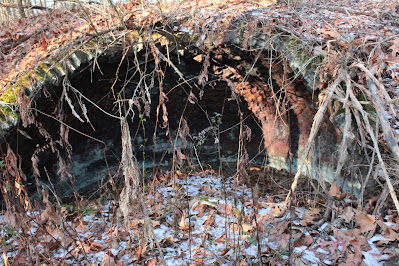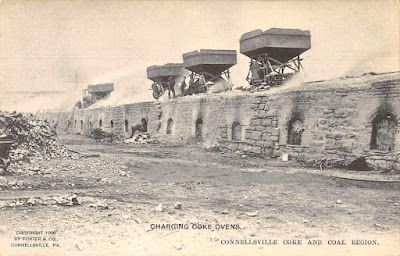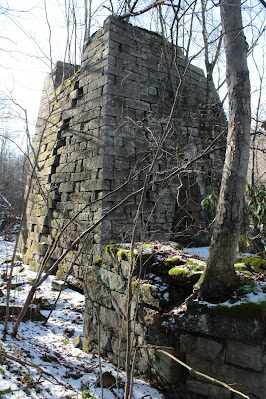Last week, Frank Festa and I took a ride into Fayette County to visit the Dunbar area. Located a bit south of Connellsville, it is a little over an hour away from my house. I’ve been here numerous times and whether hiking, exploring, rock climbing or off-roading in the Jeep, I have ALWAYS enjoyed myself.
To make the most of the day, we left before the sun rose. While we were loading my car we stopped for a minute to watch the Chinese Space Station pass overhead, talk about good timing!
About an hour later we stopped at West Overton Village to take some pictures of the buildings. (and to find a geocache) The village’s principal business was whiskey production. This is where Henry Clay Frick was born in 1849. His father, John W. Frick worked for Mr. Overholt in his grist mill and eventually married Overholt’s daughter Elizabeth. Henry came along a short time later and after growing up, he worked here and at the Overholt Distillery in Broad Ford before moving into the coal and coke industries.
Soon afterwards we were driving down into the small community of Dunbar. Our first stop was a field where the ruins of several lines of coke ovens sat. Since this is located on private property, we made sure to obtain permission before venturing past the No Trespassing signs.
If we hadn’t known that the coke ovens were here, we would’ve never guessed it. There were high weeds and plenty of thorned bushes with lots of deer trails running through them. Numerous fallen trees hampered our way into and around the site.
We soon saw the darkened openings of the ovens. The fronts of all most all of the ovens had been destroyed. This was done to avoid taxation. Up close, we could see the beautiful work that was done making these ovens.
They are called “Beehive” ovens because of their shape. They were used to make coke out of coal. Fireproof bricks were laid in a circle and built up like an igloo. A round hole was at the top center.
The broken edges show how the brick was laid; the heat inside the oven is evident by the scouring and glazing on many of the bricks.
There are three rows of ovens here with ovens on either side. There are approximately 35 ovens per side, about 70 per row. A few ovens sit closer to the road possibly part of another row that was destroyed when the road was put in, there may have been more here at one time. This is just a small number of ovens in the area, the Dunbar area had over 20,000 coke ovens in 1900!
The ovens were loaded from the top and once the process had been completed, bricks set in an opening in the front were removed and the finished coke was pulled out to be taken by horse, mule or train to iron furnaces and later, steel mills.
After “roaming” around the field for an hour or so, we returned to town and parked in front of the Dunbar Historical Society. This organization is a wonderful place to get information about the coal, coke and iron industries that used to be located in this area. The volunteers here have always been more than helpful whenever I’ve stopped in to ask for some help on research. A reproduction of a coke oven sits in the park across from the society.
We hiked about a mile on the Sheepskin Trail to a spot where 78 more coke ovens had worked. These were called the Uniondale Ovens. Three ovens still have their fronts attached. Iron bars have been placed across the openings to protect them from vandals, making them look like a jail. A sign explains how the ovens worked along with a picture of ovens in use.
Back at the car, we drove about 5-6 miles into the State Game lands to search for the Old Laurel Iron Furnace. Using Sharp and Thomas’s book, A Guide to the Old Stone Blast Furnaces in Western Pennsylvania, we had a pretty good idea of where it had been located. The book was written in 1966 and a lot of things have changed in the past 58 years. The stream the authors mention as sitting beside the furnace is listed as Laurel Run, on my topo maps it is called Morgan Run.
We parked in a convenient spot and walked down stream, looking for anything that might have been an iron furnace. We found a large pile of stones and dirt against a hillside near a nice flat area. On closer inspection we found some cut stones and a small section of wall made out of stacked stones. A pit or depression sat beside the mound with a couple sets of stacked stone, perhaps a waterwheel pit.
Snow hid a lot from us but we did find some slag and that indicted that a furnace had sat near here at some time in the past. In the S&T book they said that the outer stones of this furnace were removed, possibly to help in the manufacture of the New Laurel Furnace, a mile or two further downstream. Looking at what we had found, we were pretty sure that this mound was all of what is left of the Old Laurel Furnace. The Old Laurel Furnace had been built in 1797, two hundred and twenty-seven years ago!
Back at the car, we continued further into the game-lands. The road degraded into a dirt and gravel road covered with snow and ice. We drove with-in a ¼ mile of the New Laurel Furnace and then opted to walk the rest of the way due to the steep hill in front of us. The last thing we wanted to do was to get stuck at the bottom of a hill miles from the nearest paved road.
The New Laurel Furnace sits between the juncture of two roads, one continuing on downhill to the Youghiogheny River and the other crossing Morgan Run and leading up into the hills.
This furnace was built in 1812. Considering how long it has been standing, it is in fairly good shape. The front face has collapsed and the walls of the remaining sides all show signs of shifting and movement. There are trees growing on it and their roots are pushing the stones further apart. The backside has a large crack from the ground to the top, resembling a large zipper.
On the east side the remaining arch can be seen. There is also a stone structure sitting close to the furnace on this side which may have been a support for a water wheel. This set of stones has a tree growing on it also, slowly destroying the nicely set stones.
At the top of the backside, a notch where the loading bridge was attached can be seen. Looking from the front, the curvature of the inner chimney can be seen near the top.
Slag can be easily found in the ground surrounding the furnace.
Even though it is falling down, it is a grand looking structure. After all these years, the remaining corners are still straight and sharp. It is hidden in the woods where only hunters, explorers and historians would see it. I always enjoy visiting the site. It is quiet here, in the summer it is hidden by weeds, trees and jagger bushes and in the winter it is on display with a snowy covering.
It is quite different here than when it was in operation. Numerous buildings would have been near-by. Smoke and noise would have filled the air. Workers would have been busy with the operations of the furnace and all the additional jobs required keeping it in blast. The furnaces worked non-stop, 24 hours a day for as long as possible. This furnace went out of blast, or shut down, in 1838, allowing peace and quiet to return to the area.
Frank and I hiked back up the hill to the car and after a quick stop at the Dunbar Historical Society to say hello, we headed back home. We had found everything we wanted to, the weather co-operated and other than a few punctures by thorns, there were no injuries!
Back at Frank's car we watched a plane fly underneath the moon as we unloaded the car, a good way to end the trip. Returning home, I was tired but happy!
























2 comments:
A lot of history in Dunbar. The trips we had there were always interesting.
Mmmmm......jagger bushes. That is straight up Pittsburghese. No one dahn here ever heard of a jagger bush. Yeah & they don't say jag-off either. Use it in a sentence......"That jag-off took off thru them jagger bushes." Hahahhaah. They only shut down the coke oven at J&L Steel once a year. For maintenance & such. Cause it takes really long to heat it back up again.
Post a Comment